GREEK ADVENTURERS: MYTHOLOGY

ORION: THE MIGHTY HUNTER
The first mythical voyager, who is characterised by Robin Hard as something of an "uncouth being," is Orion. According to the Hesiodic Astronomy [Fr. 4], "he was the son of Euryale, the daughter of Minos, and of Poseidon, and that there was given him as a gift the power of walking upon the waves as though upon land."
In common with many more developed heroes, his career included a journey to the farthest reaches of Greek geographical and eschatological thought: -
Though this is a journey to the east, in the manner of a primitive Argonautica, Orion also has western myths: Fragment 5, discussing the Straits of Messina between the Italian mainland and Sicily, has this to say: "[s]ome say that great earthquakes occurred, which broke through the neck of land and formed the straits, the sea parting the mainland from the island. But Hesiod, the poet, says just the opposite: that the sea was open, but Orion piled up the promontory by Peloris, and founded the close of Poseidon which is especially esteemed by the people thereabouts."

This endeavour is echoed in the myths which connect Heracles to the pillars which bear his name.
Additionally, Orion is associated with Artemis.
Fragment 4 continues: "[b]eing disappointed, then, in his search for [Oenopion], Orion went away to Crete and spent his time hunting in company with Artemis and Leto."
A further encounter with a monstrous force ensues: -
This account is one of many for Orion's demise and translocation into the heavens. Fragment 5 presents another, in which, after settling on Euboea, he was translated skyward "because of his renown [...] and won undying remembrance."
This is in contrast to the brief notice in the Odyssey [5.121-124]: -
The probable western location of Ortygia in the imagination of the author has been dealt with elsewhere. At a later period, the island came to be occasionally identified with Delos, but Homer places it on the route to far-off Syrie.
The Syracusan Ortygia is close enough to be associated with Orion's activities in the Straits of Messina, which, at the time, would likely represent the westernmost horizon of Greek knowledge.
Homer also mentions Orion [11.572-575] alongside two other gigantic sons of Poseidon, Otus and Ephialtes (the Aloadae), in Hades [11.305-320]: -
Patently, despite the disagreement over the mechanism of his death, the tale of Orion was already well-known enough in the decades around the turn of the 7th century to render Orion as proverbial for gigantic stature and good looks.
His fame would wane as the stories of more sophisticated heroes developed, prompting Hard, in his summary of Orion's career, to state: "[t]hough evidently a major hero in early times, as is amply attested by these allusions in Homer and by the very fact that a splendid constellation was named after him, it would appear that he came to seem excessively crude and primitive as time progressed, for he was eclipsed by heroes like Perseus and Herakles and sank into relative obscurity."
PERESUS ON THE GORGONS' ISLE
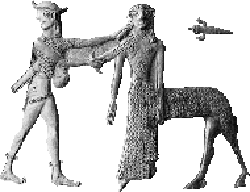
One of the most famous myths bequeathed to modernity by the ancient Greeks is that of the Danaan hero Perseus.
According to legend, Perseus was the son of Danaë & a descendent of Io, a primordial Greek heroine who descended into Egypt and whose great-great grandson Danaus returned to Greece, claiming the throne of Argus. Perseus and his mother were sent into exile by the boy's grandfather Acrisius as a result of an oracle and he was brought up on the island of Seriphos. His most famous adventure took him to the furthest reaches of the world in a quest to kill the only mortal member of the three Gorgons, Medusa.
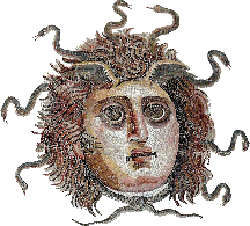
As early as the time of Hesiod, the tragic tale of Medusa appears to have been told. According to later fancy, once a woman of great beauty, Medusa slept with (or was violated by) Poseidon in the temple to Athena in which she worked, whereupon she was transformed into the fearsome snake-haired monster of popular culture.
In common with Plato's Cleito and the tale of the Aloadae, her liaison with Poseidon produced twin children: -
The statement that Pegasus "was born near the springs of Ocean," as well as the location of Medusa's tryst with Poseidon, is suggestive of a far-western location identical with the Homeric Ogygia.
The Gorgons' home, however, is called "Sarpedon, a rocky island in deep-eddying Oceanus" in the Cypria [Fr. 21], recorded by the 2nd-3rd century AD writer Herodian. Stesichorus, writing in the century after Hesiod, used the term "Sarpedonian" to describe "an island in the Atlantic sea" in his Geryoneis [Fr. 586].
The description of the Gorgons living "beyond glorious Ocean in the frontier land towards Night" and the presence of the "Sarpedonian" island in the Atlantic are indicators of a location in the far west, though the locative Sarpedon also had a northern connection: Simonides [Fr. 534] "says that Orithyia was carried off from Brilessos and taken to the Sarpedonian rock in Thrace."
The 5th century tragedy Prometheus Bound places the Graeae and Gorgons in the east, the Graeae being found at the "Gorgonean plains of Cisthene," which is found after travelling due east upon crossing "the stream that bounds the two continents."
Though a Cisthene is known from Mysia in Asia Minor, the stream in question here is likely the Red Sea and thus these plains would appear to be in Arabia at the nearest, though pseudo-Hyginus [Astronomica 2.12] perhaps suggests that Aeschylus, in his lost Phorcydes, places the Graeae near Lake Tritonis and has the Gorgons not too far away.
Much later, Pausanias [2.21.5] provides a heavily-rationalised form of the myth, making Medusa - who remains a beauty in the tale - the queen of a region around Lake Tritonis: -
In light of the Cypria's description of Sarpedon and the Gorgons' descent from the dangerous sea gods Phorcys and Ceto, Aaron Aardsma suggests that "Hesiod seems to have imagined the Gorgones as reef-creating sea-daemones, personifications of the deadly submerged reefs which posed such a danger to ancient mariners," an identification which would also serve to tie them to the far west, the home of a wide variety of submarine hazards which Plato makes the result of Atlantis' submergence.
Of Poseidon and Medusa's monstrous offspring, Pegasus is the famous winged horse which accompanied the Corinthian hero Bellerophon on his adventures in Asia Minor. Chrysaor is something of a cypher, his only real notices being those associated with his birth from Medusa and his being the father of Geryon, an opponent of Heracles.
The legend of Chrysaor's springing from Medusa's neck armed with a sword of gold is reminiscent of other accounts of warrior figures born in arms: Athena, the Spartoi of Thebes and, of course, Theopompus' Machimoi.
Attempts have been made to render him an alter-ego to Bellerophon. A Carian settlement had claimed to have been founded by another Chrysaor, the great-grandson of Bellerophon, strengthening the identification of the hero with the lineage of Poseidon and Medusa. That Chrysaor was located in the furthest west is explicit in the myth of his son, who was based on the island of Erytheia.
Chrysaor is also occasionally given as the parent of Echidna, whereas elsewhere she, like the Gorgons and Graeae, is a daughter of Phorcys and Ceto. This latter pair were also commonly believed to have sired the aforementioned serpent Ladon (who is alternatively the child of Echidna). Apollonius Rhodius [4.1505 ff.] makes the blood dripping from Medusa's neck the cause of an infestation of dangerous serpents in Libya.
With regards to the Gorgons' monstrous powers of petrification, H.J. Rose suggests that "[t]he kernel of the myth is, that there existed sometime and somewhere a creature of aspect so terrible that those who saw her turned at once into stone."
Perhaps this notion shares a pedigree with the Mesopotamian eschatological myth, which places "scorpion men," Aqrabuamelu or Girtablilu, as guardians of Mount Mashu, the location of the sun's rising and setting: -
Both the Gorgons and scorpion men, who came to be regarded as descendants of the primordial pair Apsû and Tiâmat, are located at the extreme horizon of the earth, though the possibility that the scorpion men could kill by sight is the only other similarity: they are explicitly guardians of the gate to the netherworld ("[f]rom sunrise to sunset they guard the sun" - ibid.), through which the hero Gilgameš wishes to travel and they function as a society similar in many ways with that of humans: they marry, and thus are formed of two sexes, as opposed to the Gorgons, who are three females.
Additionally, Gilgameš "beheld them, and with fear and terror his face grew dark. His mind became confused at the wildness of their aspect," though he is not petrified or killed (albeit he is two-thirds god and only one-third man).
Medusa and her sisters can also be compared with Gilgameš and Enkidu's powerful enemy, the forest guardian Huwawa (or Humbaba), "whose roar is a flood, whose mouth is fire, whose breath is death" [Tablet 4]. Both adventures involve travel to the western extremity of the known world (in the case of Huwawa, he is located in the Forest of Lebanon) and Huwawa's severed head may be a prototype of Medusa's.
Late traditions also associate Perseus with the Atlas Mountains: according to the poet Polyidus, Atlas was the name of a Libyan shepherd met by Perseus on his way back from slaying the monster: -
Perseus' other famous exploit is his rescue of Andromeda, the Ethiopian princess of Joppa on the Levantine coast, from the jaws of a sea monster. Though Ethiopians and sea monsters also figure in tales associated with the Atlantic, it is unlikely that this part of Perseus' cycle can be located in the west.
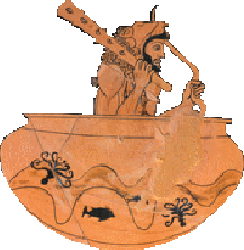
THE LAST LABOURS OF HERACLES
Amongst his manifold exploits, Heracles was compelled to carry out a series of twelve "labours," at the behest of his cousin Eurystheus, primarily due to the machinations of his nemesis Hera who ensured that Heracles would be compelled to serve Eurystheus.
Initially taking the form of a variety of specific acts in the Peloponnese, especially monster-killing, the later labours necessitate Heracles' ranging further afield. Of especial interest to the present discussion are the final three.
THE CATTLE OF GERYON
Heracles' tenth labour was a castle-rustling mission to the far-western island of Erytheia ("red"), to seize livestock belonging to the three-headed Geryon.
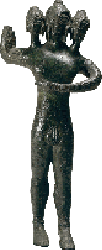
As early a writer as Hesiod records Geryon as the son of Chrysaor and the Oceanid Callirhoe [Theogony 287-288] and gives a brief account of Heracles' seizure of the cattle [289-292]. Whether or not this was part of a canon of twelve specific exploits is unclear.
Indeed, Bruce Lincoln, in his essay comparing Indo-European cattle raiding myths, discusses the probability that Geryon himself was the original cattle thief, only to be robbed in turn by Heracles, a situation which would mitigate against Hesiodic familiarity with the later canon of labours.
There is a Platonic reference to Geryon embedded within the Gorgias [484bc]. It appears in a speech by the villainous Callicles, who argues that "might is right" and cites Pindar's treatment of the myth of Heracles and Geryon as evidence that "taking it as a natural right that cows or any other possessions of the inferior and weaker should all belong to the superior and stronger."
Callicles is most likely an invention on the part of Plato, drawn up specifically as an anti-Socrates. Rachel Barney suggests that Callicles is imagined as what Plato believes he would have been had he not come across Socrates.
D.L. Pike, however, notes that Pindar's treatment of the Geryon myth is juxtaposed to an account of another labour, that of Diomedes of Thrace and his horses, and suggests that Heracles' use of violence, though unpleasant, is justified by the monstrous nature of his adversaries.
Additionally, Plato mentions Geryon in the Laws [7.795c] alongside Briareus, in the context of a speech by the Athenian Stranger espousing the virtues of being able to use both hands to their full potential.
Between the time of Hesiod and that of Plato, however, this tale had developed considerably. Stesichorus introduces Menoites, the herdsman of Hades, indicating the intended location in the far west.
As quoted by Strabo, he identifies the Baetis (Guadalquivir) with the Tartessos: "[t]he ancient writers seem to call the Baetis [a river in southern Spain, now called Guadalquivir] Tartessos, and Gadeira [Gades, now Cadiz] and the nearby island Erytheia," quoting Stesichorus as saying that Eurytion "was born almost opposite Erytheia [...] by the limitless silver-rooted waters of the river Tartessos in the hollow of a rock."
Aaron Aardsma suggests that Menoites is possibly the titan Menoiteus, otherwise banished for his part in the war against the Olympians [Hesiod]. Aardsma reasons that, as Atlas and Prometheus, brothers of Menoiteus, figure in the stories of Heracles' western labours, it is not too much of a stretch to imagine that Menoiteus also had dealings with the hero.
Alternatively, Hecataeus' suggestion of an Ambraciote Geryon, born from his personal cynicism towards tales locating Heracles' endeavours in the far west, would accord reasonably well with the possible correlations Aarsdma notes between the underworld Menoites and the early career of Patroclus. Heracles also battles a Menoites, the son of Ceuthonymus, after slaughtering one of Hades' cattle in the underworld [Pseudo-Apollodorus 2.125].
During his harrowing of Hades, Heracles also faces off against the god himself at the gates of the underworld, an episode perhaps conflated with his celebrated attack on Pylos (which means "gate"), during which he almost annihilated the family of Neleus.
Of significant interest is Stesichorus' locating Erytheia, which certainly reflects Plato's statement [Crit. 114b] that Atlantis extended to a point "near the pillars of Heracles up to the part of the country now called Gadeira." Later writers were unsure as to whether Erytheia was to be identified with the central island of the Phoenician foundation of Gades or a neighbouring island, as noted by Strabo: "[b]y 'Erytheia' [...] Pherecydes seems to mean Gades Others, however, think that Erytheia is the island that lies parallel to this city and is separated from it by a strait of a stadium in width" [3.5.4].
Pseudo-Apollodorus, whilst apparently confusing the Homeric cattle of the sun with those tended by Geryon's herdsman Eurytion, identifies Erytheia with "Gadeira, lying near Oceanus." Pausanias [1.35.8] has Geryon commemorated at Gadeira, whilst Philostratus states that "[t]he city of Gadeira is situated at the extreme end of Europe" and suggests that Heracles "penetrated as far as the neighbouring city of Erytheia [...] and they say that in his devotion to wisdom he traversed the whole earth to its limits."
Diodorus [4.17.1] explains away Geryon's three heads and three bodies by making him three sons of Chrysaor, in his account the ruler of Iberia.
Much earlier (as alluded to previously), Hecataeus, pouring scorn on what he saw as the fashion for identifying mythological loci with the far-flung reaches of Greek knowledge, placed Geryon in Ambracia.
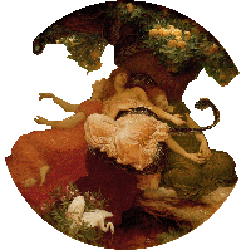
THE GARDEN OF THE HESPERIDES
Heracles' penultimate and final labours were the capture and removal of Cerberus, the guard dog of Hades, from the underworld and an expedition to the Garden of the Hesperides to procure a number of the apples of the gods which grew on a sacred tree at that location.
In his quest for the apples of the Hesperides, Heracles comes across the earthborn Libyan giant Antaeüs. Antaeüs is invincible as long as he is in contact with his mother Gaia (i.e. the ground). Thus, in order to polish him off, Heracles must hold him suspended in the air and crush him by means of a bear hug.
During his journey through north Africa, he was also said to have come across the spurious Egyptian pharaoh Busiris, who was dispatched by the hero for his lack of hospitality (Busiris was in the habit of imprisoning and sacrificing foreigners).
Despite his having already been in the far west, Heracles appears to have been unsure of the precise location of the Garden of the Hesperides: he consulted the nymphs of the wondrous far-northern Eridanus river, who advised him to seek out Nereus, a protean sea-god who, after dogged resistance (he tried the usual trick of rapidly changing shape, but Heracles managed to keep hold of him long enough to break down the god's resistance), informed him of their location.
Though they would be expected to be located in the far west, various traditions placed the Hesperides amd Atlas in the extreme north: according to Robin Hard: -
Hesiod [Theogony 215-216, 274-275, 517-519], however, places them in the west: "beyond glorious Ocean in the frontier land towards Night [...] are the clear-voiced Hesperides" [274-275].
Furthermore, Nakassis notes "the nymph Erytheia is explicitly linked to Helios in a fragment of Antimachos (fr. 66 West) in which she sends Helios to the east in a golden cup."
Towards the end of his journey, Heracles comes across Atlas, who is holding up the heavens.
In many of the myths, Atlas agrees to get the apples on Heracles' behalf if he consents to take on Atlas' burden in the meantime, to which the hero readily agrees.
However, once Atlas returns with the prize, he suggests that he, rather than Heracles, will take them to Eurystheus, whereupon Heracles invokes a ruse suggested by Prometheus, whereby he goes along with Atlas' plan on the proviso that Atlas retake his position to allow Heracles to procure a pad for his shoulders. When Atlas does so, Heracles makes off with the apples leaving the Titan to resume his duties indefinitely.
Otherwise, Heracles took the apples himself, possibly killing the large serpent tasked with guarding them in the process. This serpent, occasionally called Ladon, is perhaps analogous to the dragon guarding the Golden Fleece in Aea, which Heracles' contemporary Jason is forced to face off against.
